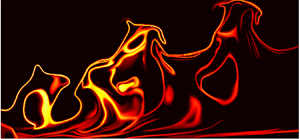Published online by Cambridge University Press: 27 July 2020

Three-dimensional flow fields of a rectangular synthetic jet with aspect ratio of 3 and its interaction with a laminar cross-flow are measured using time-resolved tomographic particle image velocimetry. The synthetic-jet to free-stream velocity ratio is fixed at 1, and two orifice orientations, normal to (spanwise configuration) and aligned with (streamwise configuration) the cross-flow direction, respectively, are investigated. The flow scenarios are composed of a tilted vortex ring, a secondary trailing vortex and a tertiary near-wall vortex. Compared to previous results for circular cases, the legs of the trailing structures are found to be jointed in the spanwise direction by two shear-layer vortices at different wall-normal heights. In addition, the near-wall vortex is a crescent-shaped spanwise vortex. For the first time, as the peculiar process of non-circular vortex rings in quiescent condition, axis switching is validated to exist in the cross-flow. Associated with axis switching, the spanwise case exhibits interaction between the leeward vortex of the vortex ring and the downstream shear-layer vortex, which causes slower penetration and recovery of vortex ring tilting, but faster jet transition. Furthermore, the trailing structures and vortex ring are weakened, leading to lower peaks of the velocity deficit and overshoot in the jet region than those for the streamwise case. On the other hand, the spanwise case can induce a stronger near-wall vortex, which transfers more momentum and initial disturbance into the boundary layer. Consequently, the spanwise case yields larger velocity gradient and velocity fluctuation peak inside the boundary layer with a lower shape factor, suggesting greater efficiency of promoting boundary-layer transition.